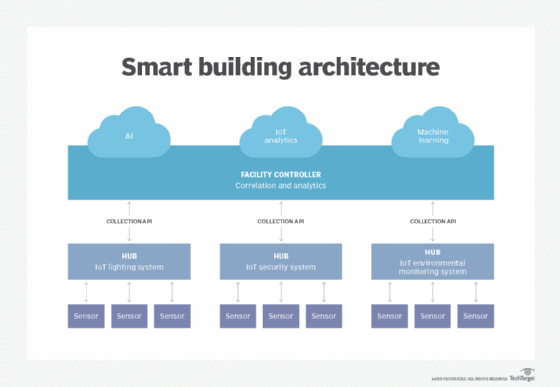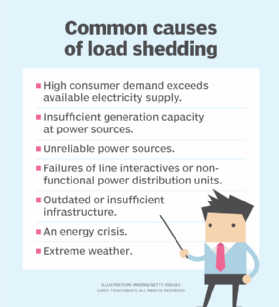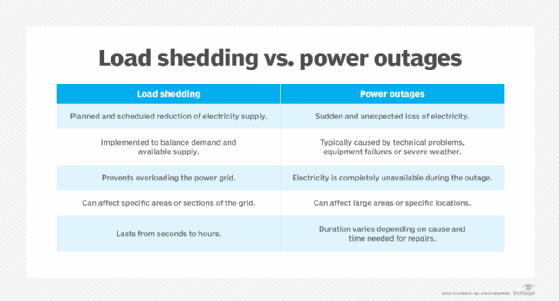load shedding
What is load shedding?
Load shedding (loadshedding) is a way to distribute demand for electrical power across multiple power sources. Load shedding is used to relieve stress on a primary energy source when demand for electricity is greater than the primary power source can supply.
The goal of load shedding is to prevent a power grid or power source from overloading. As a type of load management, load shedding works by rotating power outages or reducing power consumption from primary sources until demand decreases and more capacity becomes available. Buildings such as data centers often rely on backup power systems during times of load shed to prevent backup failures.
Load shedding is frequently planned, though it is sometimes a strategy used in the aftermath of a natural disaster or severe weather. Load shedding power cuts can last from a few minutes to a few hours. It can disrupt businesses, services, reduce productivity and upset customers or clients.
How does load shedding work?
Load shedding strategically reduces or cuts off electricity supply to different consumers or areas in a controlled manner. This process helps balance demand with available resources.
Load shedding is often planned and negotiated with local building owners. Utility providers monitor electricity demand and identify when it exceeds supply or nears capacity limits. They then create a load shedding plan that entails rotating power outages, temporary current disconnections and incentives to building owners for complying. Once demand decreases or additional power resources become available, the utility provider restores power to the affected areas.
Load shedding can also happen without prior planning. Power customers might experience involuntary load shedding when a utility electrical provider lowers or stops electricity distribution across a coverage area for a short period of time. This type of load shedding is commonly referred to as a rolling blackout. Brownouts, another type of involuntary load shedding, are caused by a power supplier lowering voltage distribution during peak usage times to balance supply and demand.
Load shedding plans
Most buildings, including data centers which use 1.8% of the United States' electricity, purchase electrical power from a power utility provider. To reduce the cost of power while also ensuring continuous operation, a building operator may negotiate an agreement with a power provider to voluntarily load shed on a pre-scheduled or on-demand basis.
During load shedding events, the building draws power from its secondary source(s) -- typically on-site diesel generators -- rather than from the utility. Some data centers are switching to green energy sources such as on-site or contracted solar photovoltaics or wind-based renewable power.
Many utilities' load management programs to shift or curtail power usage offer cost incentives to building operators who voluntarily load shed during peak periods. Load management programs are a good option for energy-intensive building operations that also have high-quality power distribution control and secondary power sources, such as a data center.
Building operators sometimes agree to demand response plans, where instead of load shedding, they promise to use less power during certain periods of time. Some are also transitioning to smart buildings, which are more energy efficient than traditional buildings.
To prevent disruption to the systems in a building, an operator can rely on uninterruptible power supply systems and power distribution units (PDUs) that moderate the flow of electricity to sensitive equipment. Small to midsize businesses and residential buildings with backup power generation might also be candidates for load management programs. Environmental protection bodies define and regulate load shedding as nonemergency use of nonprimary power in countries such as the U.S.

Causes of load shedding
Load shedding arises for several reasons, including the following:
- When high consumer demand for electricity exceeds the available supply.
- Insufficient generation capacity at power plants.
- Unreliable primary energy sources.
- Equipment failures, such as transmission line interactives or nonfunctional PDUs.
- Limitations, such as outdated or insufficient infrastructure -- for example, the use of basic PDUs over smart PDUs.
- An energy crisis, such as when a country or area particularly struggles to provide energy.
- After a bout of extreme weather when damage to the electric grid, transformers and transmission lines could lead to an energy shortfall.

Effects of load shedding
Although often negotiated ahead of time with building owners and with cost incentives, load shedding can have disruptive effects, such as the following:
- Decreased productivity, as many operations require reliable electricity to function.
- Reduced factory output.
- Increased energy prices due to limited availability.
- Disrupted household activities, such as cooking.
- Interrupted access to services such as healthcare and banking.
- Increased use of other energy sources, such as natural gas and fossil fuels, can be detrimental to the climate.
- Criminals taking advantage of alarm systems disabled by power outages.
Power outage vs. load shedding
Power outages and load shedding are similar, which can be confusing. Both, for instance, require advance planning: load shedding involves planning with utility providers while power outages require strong continuity plans. Despite each term involving power cuts and plans, they are two different phenomena.

Load shedding is premeditated and operates using load shedding schedules in which power stations negotiate incentivized power shutdowns with building owners.
Power outages are unexpected and uncontrollable shutdowns of power. They often occur during poor weather, natural disasters and equipment failures.
Unlike load shedding, which is temporary, a power outage lasts until power is restored. This can take a few hours, days, weeks or longer. In the event of both load shedding and power outages, some buildings use automatic transfer switches to switch to secondary power sources.
Load shedding prevents the overloading of traditional power grids. Learn how data centers can become less dependent on traditional power sources and become sustainable.





